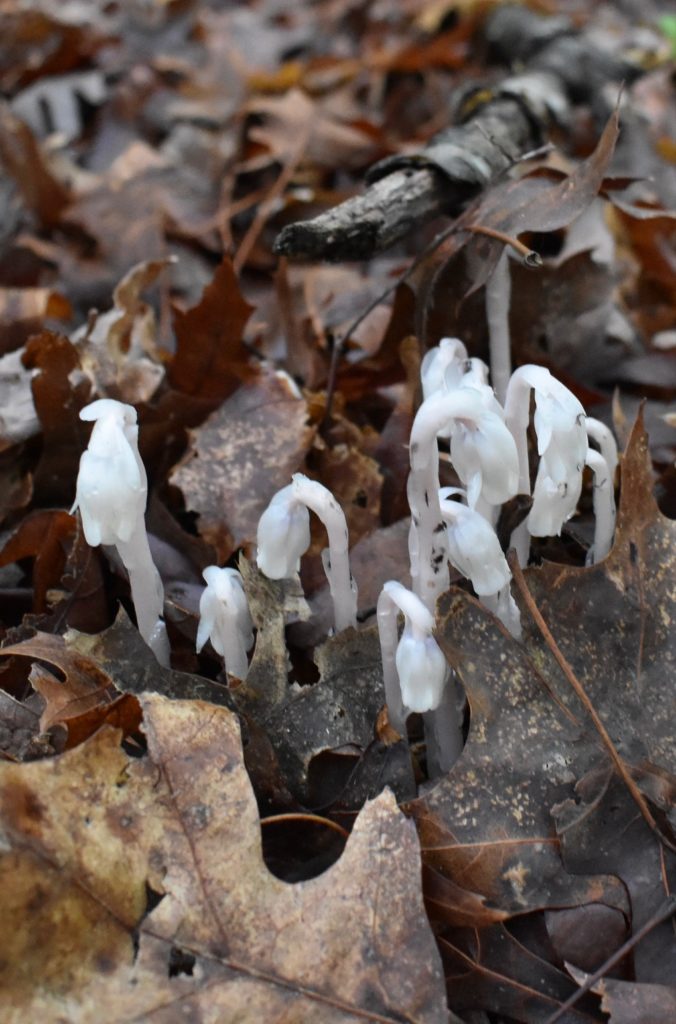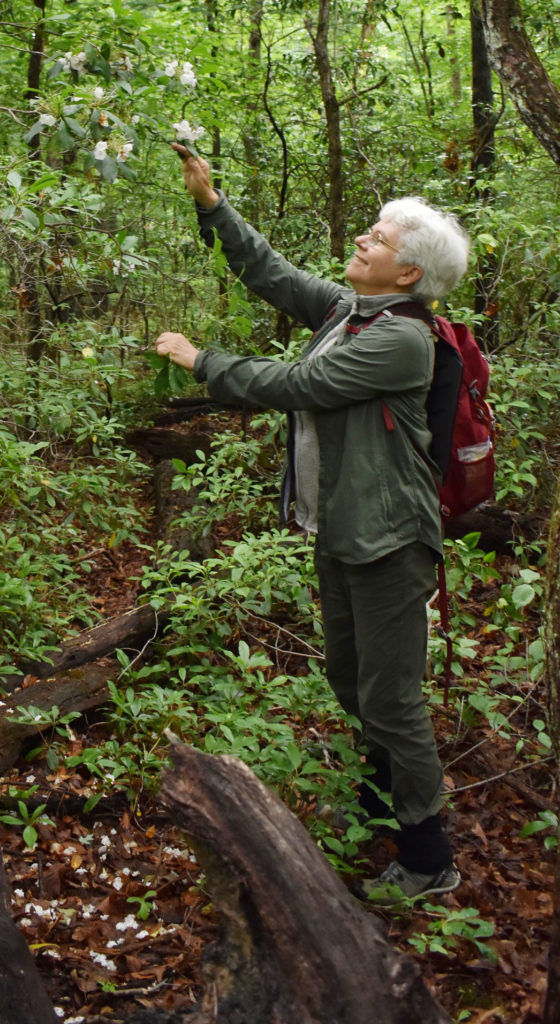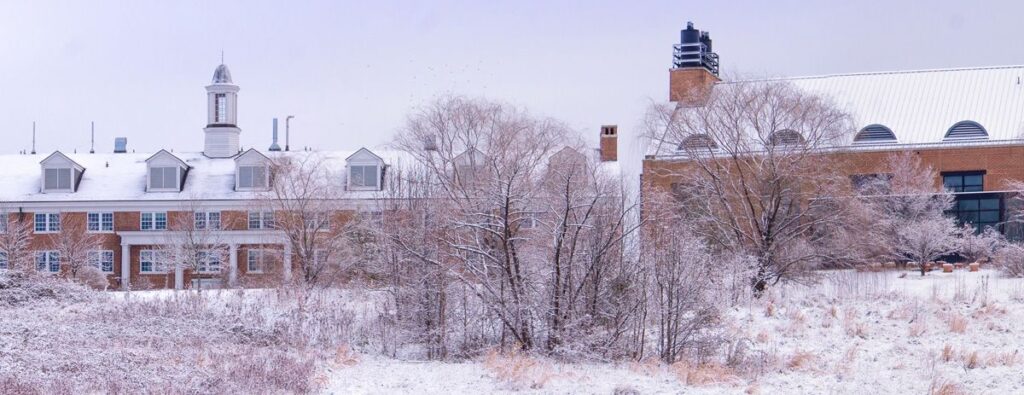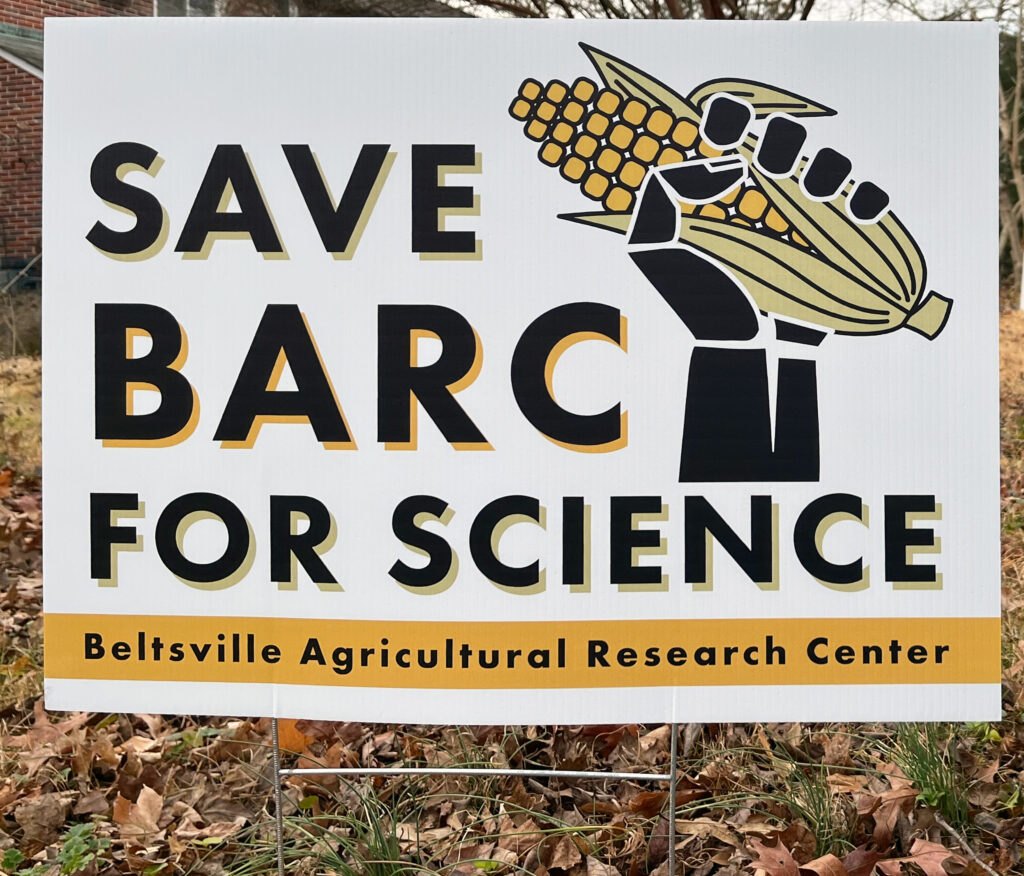When Jamie Jorgensen invited me to join Greenbelt Biota on a walk into the Beltsville Agricultural Research Center to see some “sexy heifers” my response was understandably immediate: “sign me up.” Unfortunately, that outing happened at a time I had other plans, but Greenbelt Biota were quick to accommodate me. We met for a walk in the Greenbelt Homes Inc. woodlands and the Greenbelt Forest Preserve Sunday evening. Not to skip to the last chapter of the book, but I’ll tell you right now that while the forest is nice and everything, there is not a single sexy heifer to be found therein.
Greenbelt Biota members Jorgensen, Catherine Plaisant, and Maria Hult met Dan Hamlin and me in the green space near the intersection of Laurel Hill and Ridge Road, from where we entered the woodlands on the GHI Yoga Trail, a trail I had hitherto not known existed. The adventure began before we even got into the woods, as we stopped to eat some serviceberries and learned they are a member of the rose family. I had never eaten
serviceberries before; I am not sure I had heard of serviceberries before, and I was therefore delighted to learn they exist and that I can eat them. (Note to readers: don’t take my word for it. I will definitely get you killed in the forest within forty-two seconds of entry. But if you go with someone who knows what’s up, you can find things upon which to survive, and if you’re like me, a huge part of your identity is wrapped up in your belief that you can survive avalanches, plane crashes and being out in the Forest Preserve all by yourself for more than one hour, if only given the opportunity.)
I was a little suspicious when all three Greenbelt Biota members arrived on the scene wearing long-sleeved shirts, hiking shoes and long trousers with their socks pulled up over the cuffs. I looked down at what I was wearing: running shoes, white short socks that don’t even make it to the top of my shoes, a purple T-shirt made for someone 60 pounds lighter than me, and a pair of leggings that end far above my ankles. One of these kids didn’t look like the other kids, and I figured I would probably end up covered with ticks and laid low with Lyme disease but I comforted myself in knowing that I was doing it for you, fair readers of the News Review. (Spoiler: I didn’t pick up any ticks. But you should probably dress appropriately anyway.)
I actually walk in the Forest Preserve fairly frequently, but it was an entirely different experience going with people who know about plants, who are bright and curious and who are such lovely, warm companions. They showed us a wide variety of ferns: Christmas, lady, cinnamon, hay-scented and New York; taught us how the leaves of hay-scented ferns have three little cuts while New York fern leaves are flatter. They showed us sassafras, and how the leaves on a single plant can show such variety – one leaf can have no indentation, another can have one indent, the next two or even three. As we walked and talked, they would name plants – common names, scientific names – would discuss the history of them, what we can learn about the forest based on the plants there are in it.
When Plaisant pointed out the number of mountain laurels (Kalmia latifolia) in bloom at the end of Laurel Hill Road I felt the lightbulb over my head dimly begin to flicker on. It hadn’t occurred to me to be curious about why Laurel Hill was so named, but out with Greenbelt Biota answers I didn’t know I was missing began to arrive. They showed us arrowwood viburnum (Viburnum dentantum) and explained it is so named because indigenous folks would use its strong shoots to build arrows. They showed us devil’s walking stick (Aralia spinosa), full of spines, and, having taken my measure early on, also told me it would not make a good walking stick. They showed us a strawberry bush (Euonymus americanus) – “in the fall they make beautiful red and pink flowers,” Plaisant said. “Deer eat all the leaves but the stem is green so it photosynthesizes anyway.” Later they showed us ghost pipe (Monotropa uniflora) which doesn’t photosynthesize and instead pulls its nutrients from fungi, the fungi in turn getting its nutrients from trees.

They showed me lady’s slipper orchids – the tell-tale two leaves from where a flowering stem will emerge, and once we found the remnants of a bloom. I am familiar with orchids from the not small number of murder mysteries I have read that feature passionate (and occasionally murderous) orchid collectors. I understand orchids are a thing that people can feel quite strongly about, and it was amazing to think that but a few feet from my front door such flowers grow. Even if they aren’t the kind of orchids people sail oceans for, there are orchids nonetheless right here, right in the woods, right in Greenbelt. “Lady’s slippers always grown in pines,” Plaisant explained, pointing out the large pitch pine near us, “but there aren’t that many left here because the pines are disappearing. In the life of a forest, pines come early and then they are replaced by other things.”
They showed us the different forest communities on our walk – the pine heath community at the top of the hill and, below it, the oak heath understory. They explained mountain laurel, wild blueberries – of which we saw many and sampled a few – and azaleas are all part of the heath family. I tried to nod sagely as they talked, as though I knew what they were talking about, as though I could identify plants in more meaningful terms than green and orange but it was clear this charade was not necessary. They were warm and inviting and interested and curious and were happy to talk plants and animals with me, no competition, no need to know what I did not yet know. I cannot think of a time in my life when I have been around a more inviting group of people. I came home and immediately ordered a field guide to plants in Maryland, because my newly-opened eyes and mind want now to learn and to understand more.
Greenbelt Biota was started in 2005 by Jason Martin and its first group outing was in February of that year with a walk in the Forest Preserve. They meet on the second Tuesday of the month at 7:30 p.m. to plan upcoming walks. They have an active Facebook Group with nearly 500 members and anyone interested in joining them are invited to connect with the Facebook Group or come to the next meeting.





